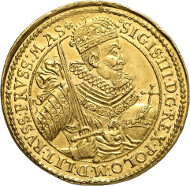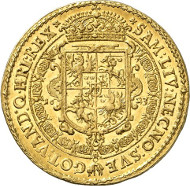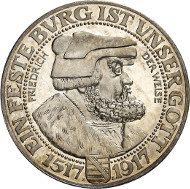29-06-2014 – 03-07-2014
Auction sales 249-252
Top prices realized in jubilee auction week at Künker’s
It was a gorgeous celebration that took place on the occasion of Künker auction #250 in Osnabrück on 2 July, 2014. More than 300 guests gathered to join in and embrace the opportunity to examine the new business premises in Nobbenburger Straße 4a first-hand. Naturally, all these guests were keen bidders as well during the auction week over the course of which 5,000 lots changed hands in four auction sales. The total hammer price of 9.3 million euros, hence more than 50 % above the estimate of 6.15 million euros, testified to the market being quite healthy.
Jubilee auction sale 250 – Coins of the Kingdom of Prussia: The Masuren Collection
A magnificent event was the 250th Künker auction sale during which the Masuren Collection was sold. In the morning, Oliver Köpp compared it with the most important collection of Prussia that was ever auctioned, i.e. the one of Otto Killisch von Horn in Berlin that came on the market in 1904. The baron, however, would have been amazed to see what prices the rarities in finest grades are able to realize!
Lot 2753: PRUSSIA. Frederick II (1740-1786). Speciesthaler 1755, Berlin. Dav. 2592. First strike. About proof-like. Estimate: 30,000,- euros. Hammer price: 65,000,- euros.
65,000 euros was the sum for which the splendid first strike of the speciesthaler 1755 of Frederick II, which was never actually issued, changed hands. There are only 16 specimens of this speciesthaler, only three of which had been available on the market since WW II. The levantethaler of the very king 1767 cost 30,000 euros. And a pattern of the reichsthaler 1714 for Neuenburg under the Soldier King Frederick William I realized 40,000 euros.
Lot 2738: PRUSSIA. Frederick II (1740-1786). Prussian reichsthaler 1752 C, Cleve. Dav. 2584. Extremely rare in this grade. About proof-like. Estimate: 4,000,- euros. Hammer price: 34,000,- euros.
The surprise of the day was a reichthaler from Cleve from 1752 that stood out due to its fantastic condition. Having been estimated rather modestly, at 4,000 euros, the exceptional coin rose to the incredible sum of 34,000 euros!
We could go on talking about results in the five-figure regions. Like, for example, the Williams dor from 1740 in very fine to extremely fine that started with an estimate of 3,500 euros only to arrive at 24,000 euros in the end! Or the very rare reichsthaler of Frederick William I that obtained not the expected 8,000 euros but 22,000 euros instead. Yet all these six-figure results would only hide the fact that collectors with less money to spend had a decent chance to acquire an interesting piece as well. Just like any true collection, the Masuren Collection comprised not only an A-list but a B-list as well. Bids as low as 20 euros were accepted, and one bidder actually was lucky at that sum. Most of the lots were sold for prices ranging in the lower three-figure regions.
Auction sale 249 – Coins and Medals from Medieval to Modern Times / Münster and Westphalia, The Dieter Braun Collection
It goes without saying that the Masuren Collection was not the only highlight of this auction week. It had already started with a bombshell, albeit a bombshell that was to be expected. Künker had offered in previous auctions patterns of Chinese coins that had been produced by the Prägeanstalt Otto Beh in Esslingen in 1897. Every time so far the result has exceeded the estimate by far. This auction sale included four examples – all coming with a pre-sale price tag of 5,000 euros. There were huge differences regarding the results achieved.
Lot 460: CHINA. Prägeanstalt Otto Beh, Esslingen. Heilongjiang Province. Pattern of 20 cents (1 mace, 4.4 candareens) n. d. (1897) in brass. Unpublished. About proof-like. Estimate: 5,000,- euros. Hammer price: 75,000,- euros.
While the 10 cash piece from the Huan Province increased to ‘mere’ 11,000 euros and a 20 cent piece from the Fentien Province to 20,000 euros, the patterns for the Heilongjiang Province, adjacent to Russia, obtained 24,000 and 75,000 euros, respectively!
That a coin collection that was assembled with love, interest and expertise not only brings a great deal of joy but might become an interesting investment as well was proven by Dieter Braun who, over the course of decades, had put together a collection that was special in the literal sense of the word: Münster and Westphalia in the Context of the European Monetary History.
Absolutely every collector of this field had shown up, and so the great rarities realized the appropriate prices, and this goes not just for the eye-catching gems.
Lot 1674: MÜNSTER. Burchard von Holte (1098-1118). Pfennig, Münster. Ilisch IV, 3var. Very rare. Good very fine. Estimate: 250,- euros. Hammer price: 2,800,- euros.
This is just one telling example: you had to really know the subject to recognize the pfennig of Burchard von Holte (1098-1118), bearing lot no. 1674, as being something special. The potential customers were well aware and made the piece increase from 250 euros to 2,800 euros. Much more obvious was the case of the goldgulden of Heinrich von Schwarzburg (1466-1496) that sold for 17,000 euros (estimate: 10,000 euros). The three most expensive coins had all been struck by order of Bernhard von Galen: a 6 ducat piece 1661 realized 28,000 euros, a double ducat n. d. 34,000 euros and a 1.5 ducat klippe from 1652 likewise 34,000 euros.
Auction sale 251 – Gold Coins / Russian Coins and Medals
These, however, were by no means the highest prices the auction week witnessed. It was left for the gold coinage in auction 251 to win that title.
Lot 3145: POLAND. Sigismund III (1587-1632). 5 ducats 1623, Bromberg. Fb. 78. Only three specimens known to exist. Extremely fine to proof-like. Estimate: 125,000,- euros. Hammer price: 170,000,- euros.
The most expensive coin of the auction week became a Polish 5 ducat piece 1623 from Bromberg of which only three examples are known to exist. The bidding fight for the perfectly preserved item only stopped at 170,000 euros! That makes about 210,000 euros for the proud new owner to pay.
The other results likewise were nothing to sneeze at, though. The 5 pound piece 1839 of the “Una and the Lion” type had been estimated at 50,000 euros although the end result was not less than 65,000 euros. A rare 10 ducat piece from Czechoslovakia from Kremnitz from 1951 with a mintage of just 56 specimens brought 50,000 euros, and a Hungarian 10 ducate piece of Michael Apafi, minted in Klausenburg in 1671, 38,000 euros.
Germany saw some marvelous results, too. A 10 thaler piece of Charles I of Brunswick-Wolfenbüttel, minted in Brunswick in 1779, cost 20,000 euros (estimate: 10,000 euros), an extremely fine 5 thaler of the duke of Mecklenburg-Schwerin from 1754 realized 16,000 euros (estimate: 5,000 euros), and an extraordinarily preserved 6 ducat piece 1698 from Nuremberg on the anniversary celebration of the Treaty of Ryswick 44,000 euros (estimate: 7,500 euros).
Naturally, the Russian coins sprang many a surprise as well. A rouble of Ivan III from St. Petersburg from 1741 rose to 52,500 euros (estimate: 30,000 euros), a rouble of Nicholas I 1841 on the wedding of his son realized 40,000 euros (estimate: 15,000 euros) …
Lot 4151: RUSSIA. Alexander II (1855-1881). Gold medal 1859 by P. Brusnitsyn on the erection of the monument for Nicholas I in St. Petersburg. Diakov 681.1. Very rare. Extremely fine to proof-like. Estimate: 75,000,- euros. Hammer price: 100,000,- euros.
… while a gold medal of Alexander II from 1859 on the erection of the monument for Nicholas I even brought 100,000 euros (estimate: 75,000 euros).
A real surprise was the modest, but extremely rare silver badge from Fabergé as numismatic documentation of the beginning of the construction of Russian submarines in 1914. Having been estimated at just 1,000 euros, the impressive hammer price was 22,000 euros in the end.
Auction sale 252 – German Coins since 1871
Let us conclude this review with some remarkable results from the section of Imperial Coinage.
Lot 4705: IMPERIAL COINAGE. Saxony. Frederick August III (1904-1918). 3 mark 1917 E. On the 400th Jubilee of the Reformation. J. 141. Very rare. Proof. Estimate: 60,000,- euros. Hammer price: 67,000,- euros.
The Saxon 3 mark piece “Frederick the Wise” in proof changed hands for 67,000 euros. The 20 mark piece 1873 from Mecklenburg-Strelitz in extremely fine to proof-like increased from 10,000 euros to 21,000 euros, and the same denomination from Saxe-Coburg-Gotha from 1872 in good very fine to 52,500 euros, while the hammer fell at 30,000 euros (estimate: 20,000 euros) for a 20 mark piece 1895 for German New Guinea in about proof-like.
By the way, the unique pattern of the Saxon “Frederick the Wise” likewise rose a bit higher compared to its pre-sale estimate. It increased from 5,000 to 15,000 euros. If the new owner wanted this pattern as substitute or rather as supplement for the same piece in silver, we cannot say for sure.
You may find all results on the Künker website.
The autumn auction sales of Künker are scheduled for 6 to 10 October, 2014. The catalogs can be requested at Künker, Gutenbergstraße 23, D-49 076 Osnabrück; phone: +49 (0)541 / 96 20 20; fax: +49 (0)541 / 96 20 222; or by email.


















